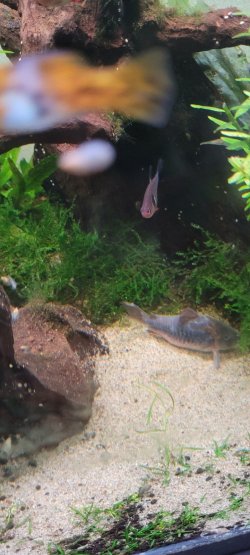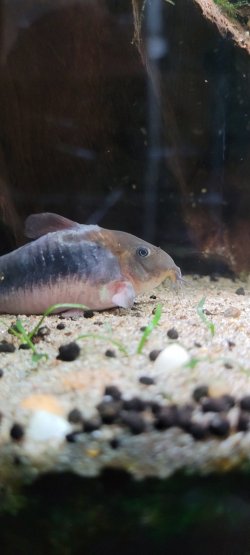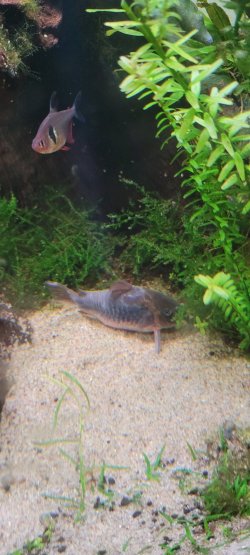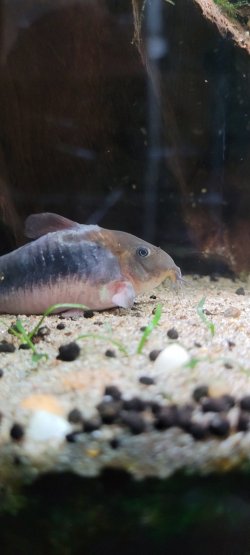-
Guest, the Tank of the Year contest is underway!
💧 Which tank will win? 👉 View the entries and vote now!!
You are using an out of date browser. It may not display this or other websites correctly.
You should upgrade or use an alternative browser.
You should upgrade or use an alternative browser.
Cory fungal growth ?
- Thread starter Basshead
- Start date
the cory is producing mucous because it is irritated about tank conditions or maybe parasitesCan anyone tell me what's wrong with my Cory please ?
usually mine get it on a small spot and then after a water change it goes away
what are the tank conditions?
Hi Sgooosh thanx for responding. Water conditions are and have been spot on since setup last April. We have a sand/bogwood/live plant 150l tank with a mixed community. We did introduce some Swordtails last month but have since removed 2 of them because they attacked this particular Cory relentlessly. All has become peaceful again but she did not have this affliction pre-Swordtails. We have 5 other corries which appear to be fine. She is by far the largest of them all so maybe just getting old ?the cory is producing mucous because it is irritated about tank conditions or maybe parasites
usually mine get it on a small spot and then after a water change it goes away
what are the tank conditions?
.
how long have the swordtails been removed? If it was recently removed maybe she is stressed from them attackingHi Sgooosh thanx for responding. Water conditions are and have been spot on since setup last April. We have a sand/bogwood/live plant 150l tank with a mixed community. We did introduce some Swordtails last month but have since removed 2 of them because they attacked this particular Cory relentlessly. All has become peaceful again but she did not have this affliction pre-Swordtails. We have 5 other corries which appear to be fine. She is by far the largest of them all so maybe just getting old ?
.
i don't think it's age, i recently got some really old cories and they are just bigger and rougher looking that normal
Swordtails been gone 1 week ishhow long have the swordtails been removed? If it was recently removed maybe she is stressed from them attacking
i don't think it's age, i recently got some really old cories and they are just bigger and rougher looking that normal
i don't think it's the swordtails then...Swordtails been gone 1 week ish
does the symptoms match this?
Slime Disease
Hi Sgooosh thanx for responding. Water conditions are and have been spot on since setup last April. We have a sand/bogwood/live plant 150l tank with a mixed community. We did introduce some Swordtails last month but have since removed 2 of them because they attacked this particular Cory relentlessly. All has become peaceful again but she did not have this affliction pre-Swordtails. We have 5 other corries which appear to be fine. She is by far the largest of them all so maybe just getting old ?
.
You say the water conditions are spot on, but we need numbers, if you have a test kit? Especially numbers for ammonia/nitrite/nitrate/pH and if possible, GH. Remember we can't test the water or see the tank ourselves. We're relying on you for info to try and diagnose.
She's covered in excess mucus, so something is irritating her, and the water is the first thing to rule out. How many fish did you add when you added the swordtails, and did you quarantine them before adding them?
How much of the water do you change, and how often? What are the water test results in numbers? Any other recent changes to the tank/stocking? Any chemicals or medications used?
Old age doesn't cause excess mucus, and some cories, especially chunky females, can grow faster than others and be large, but it doesn't mean they're old. You can't really age cories by their size, it varies so much even as a batch of fry grows, you end up with larger and smaller ones.
When and where did you get her from?
Another possibility is that some kind of parasite came in with the swordtails or other fish. What's the total tank stocking? Are you sure other fish aren't still bullying her?
Excess mucous caused by something in the water irritating the fish or an external protozoan infection (Costia, Chilodonella, Trichodina). It can be poor water quality, medications, plant fertiliser or chemicals from outside sources. Excess mucous can also be produced to covered injured areas.
Normally if fish get a cream, white or grey film over their head, body and fins, it is water quality related.
If fish get cream, white or grey patches on part/s of the body or fins, it is an external protozoan infection.
Your fish has it over most of the body and fins, but the head is clear. There is some red around the pectoral (side fin) and this is usually external protozoan. You added some swordtails a few weeks before this happened and they regularly carry external protozoan parasites, they also may have damaged her physically.
Clean the tank and add some salt. If you don't want to use salt, add a Malachite Green based medication but salt is safer.
---------------------
WHAT TO DO NOW.
Test the water for ammonia, nitrite, nitrate and pH.
Wipe the inside of the glass down with a clean fish sponge. This removes the biofilm on the glass and the biofilm will contain lots of harmful bacteria, fungus, protozoans and various other microscopic life forms.
Do a 75% water change and gravel clean the substrate. The water change and gravel cleaning will reduce the number of disease organisms in the water and provide a cleaner environment for the fish to recover in. It also removes a lot of the gunk and this means any medication can work on treating the fish instead of being wasted killing the pathogens in the gunk.
Make sure any new water is free of chlorine/ chloramine before it is added to the tank.
Clean the filter if it hasn't been done in the last 2 weeks. However, if the filter is less than 6 weeks old, do not clean it. Wash the filter materials/ media in a bucket of tank water and re-use the media. Tip the bucket of dirty water on the garden/ lawn. Cleaning the filter means less gunk and cleaner water with fewer pathogens so any medication (if needed) will work more effectively on the fish.
Increase surface turbulence/ aeration to maximise the dissolved oxygen in the water.
Add some salt, (see directions below).
---------------------
SALT
You can add rock salt (often sold as aquarium salt), swimming pool salt, or any non iodised salt (sodium chloride) to the aquarium at the dose rate of 1 heaped tablespoon per 20 litres of water. If there is no improvement after 48 hours you can double that dose rate so there is 2 heaped tablespoons of salt per 20 litres.
Keep the salt level like this for at least 2 weeks but no longer than 4 weeks otherwise kidney damage can occur. Kidney damage is more likely to occur in fish from soft water (tetras, Corydoras, angelfish, Bettas & gouramis, loaches) that are exposed to high levels of salt for an extended period of time, and is not an issue with livebearers, rainbowfish or other salt tolerant species.
The salt will not affect the beneficial filter bacteria, fish, plants, shrimp or snails.
After you use salt and the fish have recovered, you do a 10% water change each day for a week using only fresh water that has been dechlorinated. Then do a 20% water change each day for a week. Then you can do bigger water changes after that. This dilutes the salt out of the tank slowly so it doesn't harm the fish.
If you do water changes while using salt, you need to treat the new water with salt before adding it to the tank. This will keep the salt level stable in the tank and minimise stress on the fish.
When you first add salt, add the salt to a small bucket of tank water and dissolve the salt. Then slowly pour the salt water into the tank near the filter outlet. Add the salt over a couple of minutes.
Normally if fish get a cream, white or grey film over their head, body and fins, it is water quality related.
If fish get cream, white or grey patches on part/s of the body or fins, it is an external protozoan infection.
Your fish has it over most of the body and fins, but the head is clear. There is some red around the pectoral (side fin) and this is usually external protozoan. You added some swordtails a few weeks before this happened and they regularly carry external protozoan parasites, they also may have damaged her physically.
Clean the tank and add some salt. If you don't want to use salt, add a Malachite Green based medication but salt is safer.
---------------------
WHAT TO DO NOW.
Test the water for ammonia, nitrite, nitrate and pH.
Wipe the inside of the glass down with a clean fish sponge. This removes the biofilm on the glass and the biofilm will contain lots of harmful bacteria, fungus, protozoans and various other microscopic life forms.
Do a 75% water change and gravel clean the substrate. The water change and gravel cleaning will reduce the number of disease organisms in the water and provide a cleaner environment for the fish to recover in. It also removes a lot of the gunk and this means any medication can work on treating the fish instead of being wasted killing the pathogens in the gunk.
Make sure any new water is free of chlorine/ chloramine before it is added to the tank.
Clean the filter if it hasn't been done in the last 2 weeks. However, if the filter is less than 6 weeks old, do not clean it. Wash the filter materials/ media in a bucket of tank water and re-use the media. Tip the bucket of dirty water on the garden/ lawn. Cleaning the filter means less gunk and cleaner water with fewer pathogens so any medication (if needed) will work more effectively on the fish.
Increase surface turbulence/ aeration to maximise the dissolved oxygen in the water.
Add some salt, (see directions below).
---------------------
SALT
You can add rock salt (often sold as aquarium salt), swimming pool salt, or any non iodised salt (sodium chloride) to the aquarium at the dose rate of 1 heaped tablespoon per 20 litres of water. If there is no improvement after 48 hours you can double that dose rate so there is 2 heaped tablespoons of salt per 20 litres.
Keep the salt level like this for at least 2 weeks but no longer than 4 weeks otherwise kidney damage can occur. Kidney damage is more likely to occur in fish from soft water (tetras, Corydoras, angelfish, Bettas & gouramis, loaches) that are exposed to high levels of salt for an extended period of time, and is not an issue with livebearers, rainbowfish or other salt tolerant species.
The salt will not affect the beneficial filter bacteria, fish, plants, shrimp or snails.
After you use salt and the fish have recovered, you do a 10% water change each day for a week using only fresh water that has been dechlorinated. Then do a 20% water change each day for a week. Then you can do bigger water changes after that. This dilutes the salt out of the tank slowly so it doesn't harm the fish.
If you do water changes while using salt, you need to treat the new water with salt before adding it to the tank. This will keep the salt level stable in the tank and minimise stress on the fish.
When you first add salt, add the salt to a small bucket of tank water and dissolve the salt. Then slowly pour the salt water into the tank near the filter outlet. Add the salt over a couple of minutes.
Similar threads
- Replies
- 8
- Views
- 359
- Replies
- 4
- Views
- 226
Most reactions
-
 356
356 -
 154
154 -
 143
143 -
 141
141 -
 134
134 -
 134
134 -
 119
119 -
 108
108 -
 75
75 -
 70
70 -
 58
58 -
 57
57 -
 47
47 -
 45
45 -
F
44





